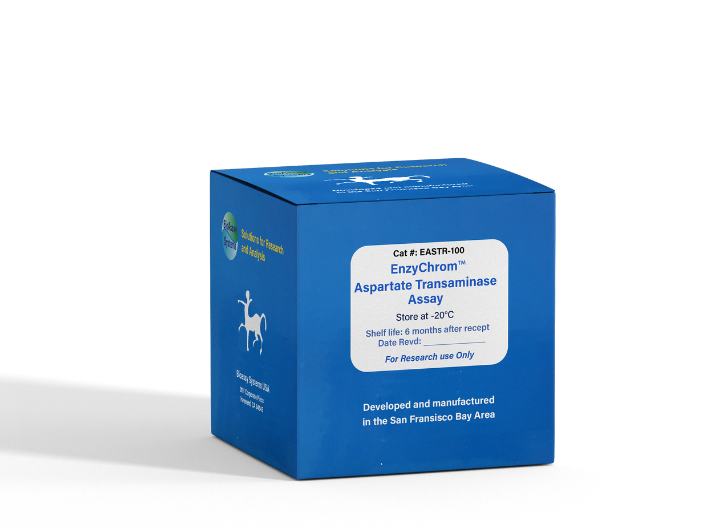DESCRIPTION
Aspartate Transaminase (AST), also known as serum glutamic oxaloacetic transaminase (GOT) or aspartate aminotransferase (ASAT/AAT), facilitates the conversion of aspartate and α-ketoglutarate to oxaloacetate and glutamate. There are two isoenzymes in humans: GOT1 is a cytosolic isoenzyme derived from red blood cells and heart; GOT2 is the mitochondrial isoenzyme found mainly in the liver. AST is elevated in liver and muscle diseases. It is part of diagnostic tests for liver function, myocardial infarction, acute pancreatitis, acute hemolytic anemia, severe burns, acute renal disease and trauma. Simple, direct and automation-ready procedures for measuring AST activity find wide applications in research and drug discovery. BioAssay Systems' AST activity assay is based on the quantification of oxaloacetate produced by AST. In this assay, oxaloacetate and NADH are converted to malate and NAD by the enzyme malate dehydrogenase. The decrease in NADH absorbance at 340 nm is proportionate to AST activity.
KEY FEATURES
Sensitive. Linear detection range: 2–100 U/L. Simple and convenient. This simple, convenient assay can be carried out in a microplate or a cuvette and takes only 10 min.
APPLICATIONS
Direct Assays: AST activity in serum, plasma and other biological samples. Drug Discovery/Pharmacology: effects of drugs on AST activity.
KIT CONTENTS (100 TESTS IN 96-WELL PLATES)
Assay Buffer: 24 mL Cofactor: 120 µL
Enzyme Mix: 120 µL NADH Reagent: Dried
Storage conditions. The kit is shipped on ice. Store all components at -20°C. Shelf life of six months after receipt, 3 weeks after reconstitution.
Precautions: reagents are for research use only. Normal precautions for laboratory reagents should be exercised while using the reagents. Please refer to Material Safety Data Sheet for detailed information.
ASSAY PROCEDURES
Equilibrate all components to room temperature. Reconstitute the NADH Reagent tube with 1000 µL dH2O (final 10 mM). Unused reconstituted NADH reagent is stable for three weeks when stored frozen at -20°C. Mix assay buffer well by vigorous shaking. Keep thawed enzyme on ice.
Assays can be performed at 37°C or at room temperature. Prior to assay, bring the working reagents, microplate and spectrophotometer to the desired temperature.
Assay is compatible with serum or plasma (heparin, EDTA). Samples should be clear and free of particles or precipitates. Hemolyzed samples should not be used.
Procedure using 96-well plate
1. Samples and controls. Transfer 20 μL sample to each well. For each assay plate, include two wells with 20 μL dH2O to be used for the NADH Standard and Blank. Keep plate at the desired temperature (e.g. 37°C).
2. Prepare Working Reagent for Sample and Standard wells, by mixing for each well, 200 μL Assay Buffer, 1 μL Cofactor, 1 μL Enzyme Mix and 4 μL NADH. Warm to desired temperature (e.g. 37°C). Prepare Blank Reagent for the Blank well, by mixing 200 μL Assay Buffer, 1 μL Cofactor, 1 μL Enzyme Mix and 4 μL dH2O. Warm to desired temperature (e.g. 37°C).
3. Add 200 μL Working Reagent to the Standard and Sample wells, and 200 μL Blank Reagent to the Blank well. Immediately tap plate to mix, incubate at the desired temperature and read OD340nm at 5 min and at 10 min. Alternatively, record kinetics at 340 nm.
Procedure using cuvettes
1. For each assay, include one Standard and one Blank control. For each Sample and Standard, prepare Working Reagent by mixing 1000 µL Assay Buffer, 5 µL Cofactor, 5 µL Enzyme Mix and 20 μL NADH. Transfer 990 µL Working Reagent to each sample cuvette and standard cuvette. Warm to desired temperature (e.g. 37°C). To Blank control cuvette, add 960 µL Assay Buffer, 5 µL Cofactor, 5 µL Enzyme Mix and 20 μL dH2O. Warm to desired temperature (e.g. 37°C).
2. Prewarm sample to the desired temperature. Add 100 μL Sample to the Sample Cuvette. Transfer 100 μL H2O to the Standard cuvette and to Blank Control cuvette, respectively.
3. Mix immediately. Read OD340nm at 5 min and 10 min. Alternatively, record kinetics at 340 nm.
CALCULATION
For each Sample, calculate the rate of NADH consumption by subtracting the OD at 10 min from the OD at 5 min (∆ODS). Similarly, calculate the rate (∆ODNADH) for the NADH standard (OD5min – OD10min). Determine AST activity using the following equation,
If the calculated AST activity is higher than 100 U/L, dilute sample in Assay Buffer and repeat assay. Multiple results by the dilution factor.
Unit definition: 1 Unit (U) of AST will catalyze the conversion of 1 µmole of aspartate to oxaloacetate per min at pH 8.1.
MATERIALS REQUIRED, BUT NOT PROVIDED
Pipeting devices and accessories. Clear bottom 96-well plates (e.g. Corning Costar) and plate reader or spectrophotometer and cuvettes for measuring OD340nm.
PUBLICATIONS
1. Ishak Gabra, M. B., et al (2020). Dietary glutamine supplementation suppresses epigenetically-activated oncogenic pathways to inhibit melanoma tumour growth. Nature Communications, 11(1), 3326.
2. Amor, C, et al. (2020). Senolytic CAR T cells reverse senescenceassociated pathologies. Nature, 583(7814): 127-132.
3. Simion, V., et al (2020). A macrophage-specific lncRNA regulates
apoptosis and atherosclerosis by tethering HuR in the nucleus.
Nature Communications, 11(1), 6135.
